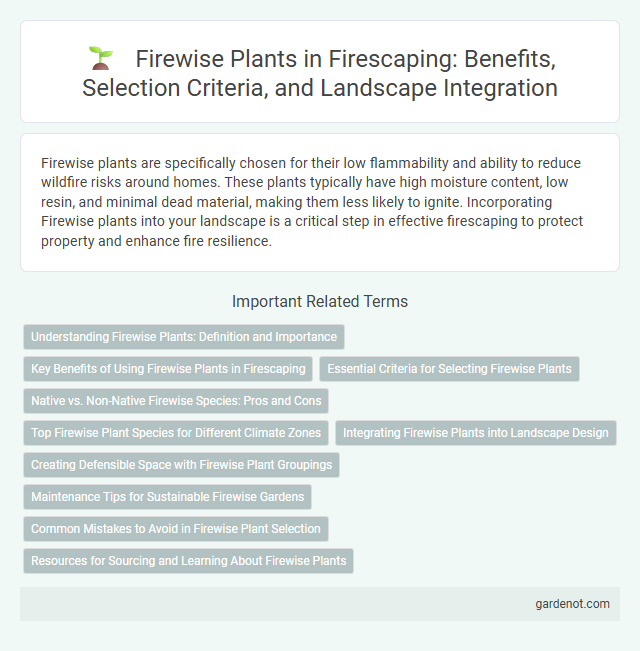Firewise plants are specifically chosen for their low flammability and ability to reduce wildfire risks around homes. These plants typically have high moisture content, low resin, and minimal dead material, making them less likely to ignite. Incorporating Firewise plants into your landscape is a critical step in effective firescaping to protect property and enhance fire resilience.
Understanding Firewise Plants: Definition and Importance
Firewise plants are species that have low flammability traits, such as high moisture content, minimal resin or oil production, and sparse leaf litter, making them less likely to ignite and spread wildfires. Incorporating these plants into landscaping significantly reduces fire risk by creating defensible space around properties and enhancing fire resilience in fire-prone areas. Understanding the characteristics and benefits of Firewise plants is essential for effective firescaping and wildfire mitigation strategies.
Key Benefits of Using Firewise Plants in Firescaping
Firewise plants significantly reduce wildfire risk by possessing low flammability, minimal resin content, and high moisture levels, which help slow fire spread. These plants enhance landscape resilience, protect property by creating defensible space, and improve overall safety for residents during wildfire events. Integrating Firewise plants into firescaping promotes sustainable garden management and supports ecosystem health by reducing the need for chemical fire retardants.
Essential Criteria for Selecting Firewise Plants
Firewise plants must exhibit high moisture content in leaves and stems to reduce flammability, featuring low resin or oil levels that can intensify fire spread. Selecting species with a low volume of dead material and minimal leaf litter further decreases combustible fuel around structures. Ideally, Firewise plants demonstrate fire-resistant traits such as thick, succulent foliage, open branching patterns, and slow growth rates, which collectively enhance landscape safety in wildfire-prone areas.
Native vs. Non-Native Firewise Species: Pros and Cons
Native Firewise species, adapted to local climates and soils, typically require less water and maintenance, enhancing landscape resilience against wildfires. Non-native Firewise plants may offer unique aesthetic qualities or pest resistance but can pose risks such as invasive growth and reduced habitat value for native wildlife. Selecting native species supports biodiversity and ecosystem stability, critical factors in effective firescaping strategies.
Top Firewise Plant Species for Different Climate Zones
Top Firewise plant species vary by climate zone, offering fire-resistant landscaping solutions tailored to local conditions. In Mediterranean climates, species like manzanita, ceanothus, and California lilac thrive while reducing fire risk due to their low resin content and high moisture levels. For arid zones, desert spoon, agave, and Texas sage are preferred for their drought tolerance and minimal flammable oils, whereas temperate regions benefit from fire-resistant choices such as sedum, Oregon grape, and ferns that retain moisture and resist ignition.
Integrating Firewise Plants into Landscape Design
Integrating Firewise plants into landscape design enhances fire resilience by utilizing species with low flammability and high moisture content. Selecting native Firewise plants such as manzanita, ceanothus, and California lilac promotes ecosystem health while reducing fire hazards. Strategic placement of these plants in defensible spaces around structures minimizes fire spread, safeguarding property and lives.
Creating Defensible Space with Firewise Plant Groupings
Creating defensible space with Firewise plant groupings involves strategically arranging fire-resistant vegetation to slow wildfire spread and protect property. Using low-growing, moisture-rich plants with high ignition resistance within clear, well-maintained zones reduces fuel continuity and enhances firebreak effectiveness. Proper spacing between Firewise shrubs, trees, and groundcovers minimizes heat transfer and supports safer evacuation routes.
Maintenance Tips for Sustainable Firewise Gardens
Regular pruning of Firewise plants such as manzanita, ceanothus, and California lilac reduces dead foliage, minimizing fuel for wildfires. Applying mulch around these drought-tolerant species retains soil moisture and suppresses invasive weeds, promoting healthy growth. Consistent watering schedules tailored to the plants' native environment maintain resilience and reduce stress, crucial for sustaining fire-resistant garden landscapes.
Common Mistakes to Avoid in Firewise Plant Selection
Choosing Firewise plants requires avoiding common mistakes such as selecting highly flammable species like eucalyptus or pine, which can increase wildfire risks. Failing to consider plant spacing and maintenance often results in dense growth that facilitates fire spread. It's essential to prioritize fire-resistant plants with high moisture content and proper placement to create effective defensible space around structures.
Resources for Sourcing and Learning About Firewise Plants
Firewise plants are specifically selected for their low flammability and ability to reduce wildfire risk in landscaping. Resources for sourcing Firewise plants include local nurseries specializing in native and drought-tolerant species, online databases like the Firewise Plant Database by the National Fire Protection Association, and extension services from universities such as the University of California Cooperative Extension. Educational materials and workshops provided by fire departments and conservation organizations help homeowners understand proper placement and maintenance techniques to maximize landscape fire resistance.
Firewise plant Infographic

 gardenot.com
gardenot.com